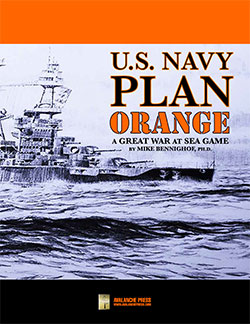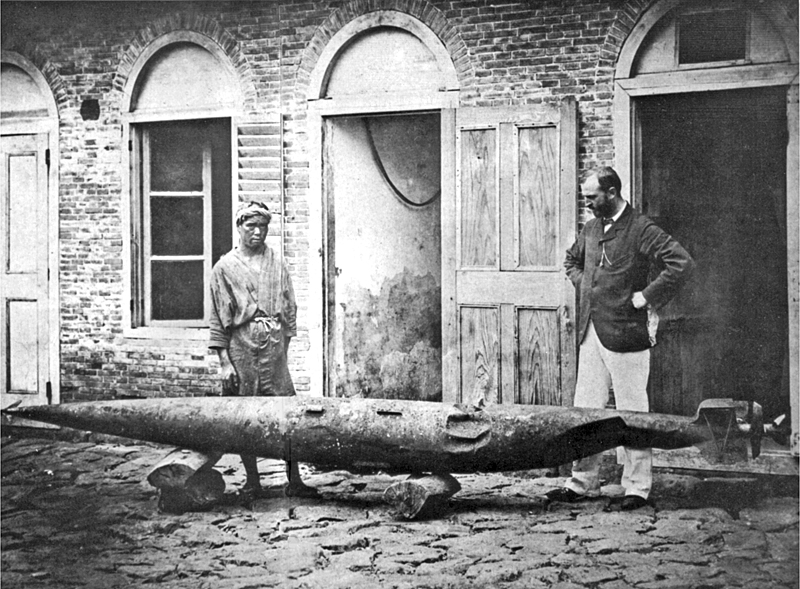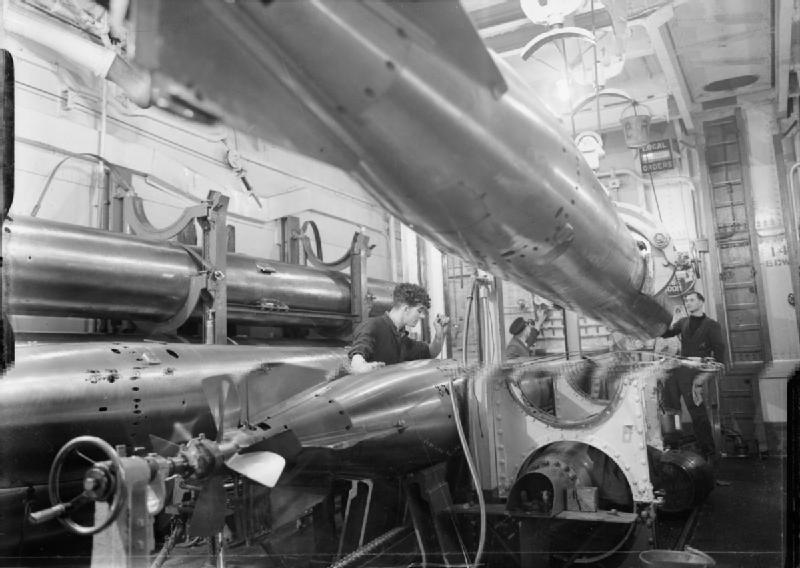| U.S. Navy Plan Orange:
The Torpedo Battleship
By Mike Bennighof, Ph.D.
July 2023
 In the 1850’s, retired Austrian Navy Capt. Giovanni Luppis began a series of experiments with a device he called a “coast saver,” a wire-guided explosive powered by a clock mechanism and intended to attack enemy warships. In 1864 he teamed up with English engineer Robert Whitehead and developed the “coast saver” into a much more effective weapon, now powered by compressed air and dubbed the “torpedo” after the torpedo ray, a fish which delivers a stinging electric shock to its foes. In the 1850’s, retired Austrian Navy Capt. Giovanni Luppis began a series of experiments with a device he called a “coast saver,” a wire-guided explosive powered by a clock mechanism and intended to attack enemy warships. In 1864 he teamed up with English engineer Robert Whitehead and developed the “coast saver” into a much more effective weapon, now powered by compressed air and dubbed the “torpedo” after the torpedo ray, a fish which delivers a stinging electric shock to its foes.
The early torpedo still needed a great deal of development thanks to its short range and undependable accuracy. To strike a target, the vessel launching the torpedo had to get very close. By the late 1800’s most navies had deployed small, fast torpedo boats to carry out these attacks, followed by equally fast “torpedo boat destroyers” to deter them.
The torpedo boat was essentially a one-shot, disposable weapon. Larger ships carried them as well, and some naval planners thought that even battleships would find their torpedo tubes every bit as useful as their heavy guns. But the experience of the Spanish-American and Russo-Japanese wars showed that battleships would rarely be in a position to use their torpedoes – though naval architects continued to include torpedo rooms in their designs despite the added expense and vulnerability. A ship would have to leave the line of battle and approach the enemy closely to launch torpedoes.

Robert Whitehead, right and his son John examine a test torpedo.
And so planners in several nations began to study the concept of a battleship armed primarily with torpedoes. In the United States, W.L. Rodgers of the Naval War College proposed a torpedo battleship in 1903, a concept eagerly taken up by F. H. Schofield. War games showed that torpedo battleships operating in pairs could be very successful in action; when deployed alone they tended to become floating targets.
However, the General Board dismissed Schofield’s proposed ship, noting that such a vessel would inevitably be sunk by gunfire before it could close the range to deliver its torpedoes. Despite the lack of approval, naval architect R.H. Robinson, the head of the Design Branch, took up the challenge to design a torpedo-armed battleship that could overcome the General Board’s objections.
The ship would have to meet incompatible goals: a high speed, to close quickly with the enemy, and heavy armor. To obtain the 30 knots sought by Schofield, the ship would need a very long and narrow hull form. Yet the long hull necessitated more armor, in turn increasing the ship’s weight and adding the need for more horsepower and hull length, increasing the need for armor in an unending cycle.
That could be mitigated by the lack of heavy guns; a large proportion of a battleship’s displacement came from her heavy gun turrets and the massive armored barbettes stretching beneath them to the very bottom of the hull. Without them, that weight could be diverted to armor and propulsion. At first, Schofield called for a ship with no heavy guns at all, but eventually accepted the need for at least some of them. Robinson proposed four 14-inch guns, all in a single quadruple turret sited forward.
The General Board had noted the results of Naval War College wargames in which the torpedo battleship became the prime target of enemy gunners during daylight engagements. She would be no more useful at night, the Board declared, since enemy destroyers would seek her out and she would be herself torpedoed. While Schofield objected to that objection – the same could be said for any battleship – Robinson set out to cover that vulnerability as well. The torpedo battleship would have forty six-inch guns, spread to cover every angle from which enemy destroyers might approach on a torpedo run.

The torpedo room of HMS Rodney.
The ship that resulted had a destroyer’s speed, a cruiser’s protection and a battleship’s main guns. Sketches varied on the number of torpedo tubes, from eight to 18, but in all variations the torpedoes launched from below the waterline – torpedo mounts located above the waterline had been shown to be a dangerous weakness, as even a small-caliber shell hit could touch off a large-scale explosion.
Robinson's ship was enormous: 800 feet long, displacing 35,500 tons. She would have been larger than any American warship then contemplated, though the Lexington-class battle cruisers then in the design stage came close (the final, enlarged version of Lexington would have exceeded the torpedo battleship’s length and displacement). She would have made for a huge target, without the armor to repel heavy shells.
The United States Navy never built a torpedo battleship, though Schofield’s studies had an impact on subsequent design philosophy. The New York class battleships, under design while Robinson was drafting the torpedo battleship, had a two-torpedo broadside (previous dreadnoughts had carried two tubes, one on either beam). The General Board directed that all subsequent battleships wield at least that many, but the designers reverted to two tubes in the Oklahoma class that followed New York and in all subsequent dreadnoughts.
All of the American battleships that survived the naval limitations treaties had their tubes removed during modernization in the 1930’s. Increasing gunnery ranges had made torpedoes obsolete as battleship armament, though other nations maintained the weapons on their battleships, and the British Rodney torpedoed the German battleship Bismarck during Bismarck’s final battle. The torpedo battleship would have had no place in the post-war fleet, obsolete only a few years after completion. They likely would have been scrapped, or perhaps converted into aircraft carriers, depending on the outcome of naval limitations talks.

U.S. Navy Plan Orange includes two examples of the August 1912 design, with four 14-inch guns, forty six-inch guns, 16 underwater torpedo tubes and a speed of 31 knots. She’s a formidable-looking playing piece; less formidable when her lightweight protection is taken into account. Will she be shot to pieces before she can unleash her deadly fish, as the General Board feared, or will she sink the enemy battle line before they can sink her, as Schofield believed? You get to game this out and decide for yourself.
Click here to join the Gold Club.
See your Gold Club Insider newsletter for ordering information.
Sign up for our newsletter right here. Your info will never be sold or transferred; we'll just use it to update you on new games and new offers.
Mike Bennighof is president of Avalanche Press and holds a doctorate in history from Emory University. A Fulbright Scholar and NASA Journalist in Space finalist, he has published a great many books, games and articles on historical subjects; people are saying that some of them are actually good.
He lives in Birmingham, Alabama with his wife, three children, and new puppy. He misses his lizard-hunting Iron Dog, Leopold.
Want to keep Daily Content free of third-party ads? You can send us some love (and cash) through this link right here.
|
